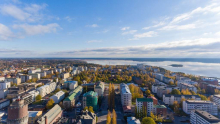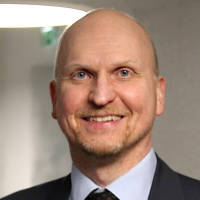
If you’re one of the more than 215 million people who live in one of Europe’s cities, chances are that you’ve recently seen efforts to make the city ‘greener.’ A 2020 report by Eurocities, a network of more than 200 European cities in 38 countries, found that nearly 90% of its members have put in place strategies to adapt to climate change impacts.
Some ‘quick wins’ to mitigate climate effects have been around for a while, ranging from the obvious (Brussels has added 40km of bike lanes since May last year) to the creative (Vienna has installed mist showers to keep plazas cool in heatwaves).
While plenty of these example technologies exist longer-term strategies need serious investment, which many lesser-known cities struggle to find. In a 2018 survey of 100 cities, 55% of municipalities said that they lacked the public funding needed to fund sustainable urban growth.
One suggested EU ‘mission’ to have 100 climate neutral cities by 2030 also notes that even with public and private funding, cities will need to create ‘innovative business models’ to reach the best climate standards.

‘’When we talk about carbon emissions in a city, you have three areas; heating, electricity, and mobility,’’ says Mika Hakosalo, an energy and climate expert at the city authority of Vaasa in Finland.
The city he explains has given itself until the end of this decade to become carbon neutral, a tough target for any city. Although not as well-known as the capital Helsinki, it is the largest university city in Finland relative to its population (around 68000). This allows it to benefit from a well-educated population and a strong R&D sector.
Energy
The region also has a strong reputation for energy research; the wider Vaasa Region has over 140 businesses which operate in an energy cluster called Energy Vaasa. Mr Hakosalo says that using that reputation is one way to attract investment for sustainable energy and heating.
‘’There’s all this knowledge & experience and all these companies and universities backing that up,’’ he says. ‘’You’re on very solid ground.’’
Vaasa is also learning from other cities to boost its sustainability. The city participates in the Finnish Sustainable Communities, a group of 11 cities working on initiatives to create a carbon neutral, waste-free and globally sustainable consumption by 2050.
The city is also part of the IRIS project, an EU-funded project that is developing strategies to help cities use technology for climate resilience. Three cities (Utrecht in the Netherlands, Nice in France and Gothenburg in Sweden) act as ‘lighthouse cities’ that test solutions for ‘follower cities’ (such as Vaasa) to replicate locally. The project says this allows cities to offer a more predictable environment to investors.
Public transport
Even if technology and strategies are available, the final hurdle of political approval remains, says Hakosolo. This is particularly difficult when investing in public transport and active travel (e.g. bike lanes). ‘’In many mid-sized cities in Finland there is a very strong car orientation,’’ he says. ‘’If you make a bike lane or remove a parking place you have to argue and negotiate.’’
Compared to initiatives in other northern European countries like Denmark and Sweden, he says in his experience more work needs to be done to convince politicians in smaller cities. ‘’In terms of carbon emissions from traffic, it’s only an investment,’’ he says. ‘’It’s not gaining savings or more income for the city. And that is that is difficult. You cannot calculate good payback times and so forth.’’
He found that politicians are more comfortable investing in these initiatives when they see them work elsewhere, such as the early successes of the ElectriCity e-bus in Gothenburg, a ‘lighthouse city’ in the IRIS project. ‘’We really need to show them practical cases,’’ he says. ‘’First, we replicate something that we know that will work and is done in some of the IRIS project lighthouse cities.’’
Playing to strengths
Cities can also show how their investment model allows the city’s strengths to flourish in the new ‘green economy’, says Mika. For Vaasa, that involved marketing the city’s reputation in energy research to companies wanting to set up battery factories for electric vehicles.
In fact Finland is one of the few European countries that has all the key minerals to make lithium-ion batteries for electric cars, with several big lithium mines within 150km of Vaasa. Paired with the nearby port and research institutes, the city stands to create thousands of new jobs in this sector. ‘’We already had a strong energy sector, it fitted in,’’ says Mika.
He says this investment can create a virtuous loop; new people arrive in the city to work, meaning the city can collect more tax to fund new investments, he says. It can win over the political sphere as well, as he says the increased transport demand will make public transport routes more attractive.
Using the energy branding could also help pioneer other sustainability solutions. Investing in hydrogen, he says, may attract car manufacturers to test their zero-emission vehicles in the city. ‘’That’s something that we were talking about, that maybe we should try to brand the city as a prototype city for new energy solutions, because we have a very good infrastructure for that,’’ he says.
It’s payback time
Mika will be sharing some of his insights on creating investment at a panel during the EU Regions Week in October. One thing he would like to see change is for cities to re-evaluate the economic model that determines the ‘payback’ of these investments.
For example, one of his previous projects in Stockholm made energy-saving investments in several residential buildings. The payback was more than just reduced energy bills, he says.
‘’We realised that when we did this, the value of the buildings went up,’’ he said. ‘’There was capital value; they’re more valuable the buildings afterwards. Without the solutions, they were less valued.’’
He would like others to broaden the economic model of these investments so that the entire value generated is included – investments that may seem loss-making may in fact create value in other areas, such as rental value and attractiveness of the area, which boosts the local economy.
‘’That is what I would also like to do when we do these kind of investment calculations,’’ he said, ‘’that we don’t miss out other positive aspects.’’
– European Science Communication Institute
15 Dec 2021

